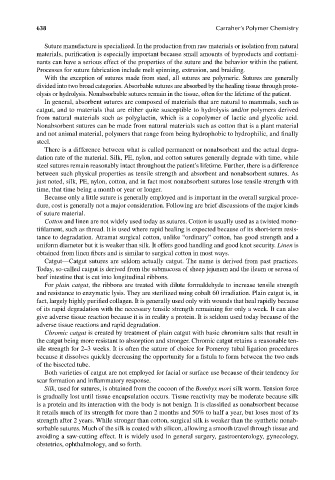Page 675 - Carrahers_Polymer_Chemistry,_Eighth_Edition
P. 675
638 Carraher’s Polymer Chemistry
Suture manufacture is specialized. In the production from raw materials or isolation from natural
materials, purification is especially important because small amounts of byproducts and contami-
nants can have a serious effect of the properties of the suture and the behavior within the patient.
Processes for suture fabrication include melt spinning, extrusion, and braiding.
With the exception of sutures made from steel, all sutures are polymeric. Sutures are generally
divided into two broad categories. Absorbable sutures are absorbed by the healing tissue through prote-
olysis or hydrolysis. Nonabsorbable sutures remain in the tissue, often for the lifetime of the patient.
In general, absorbent sutures are composed of materials that are natural to mammals, such as
catgut, and to materials that are either quite susceptible to hydrolysis and/or polymers derived
from natural materials such as polyglactin, which is a copolymer of lactic and glycolic acid.
Nonabsorbent sutures can be made from natural materials such as cotton that is a plant material
and not animal material, polymers that range from being hydrophobic to hydrophilic, and fi nally
steel.
There is a difference between what is called permanent or nonabsorbent and the actual degra-
dation rate of the material. Silk, PE, nylon, and cotton sutures generally degrade with time, while
steel sutures remain reasonably intact throughout the patient’s lifetime. Further, there is a difference
between such physical properties as tensile strength and absorbent and nonabsorbent sutures. As
just noted, silk, PE, nylon, cotton, and in fact most nonabsorbent sutures lose tensile strength with
time, that time being a month or year or longer.
Because only a little suture is generally employed and is important in the overall surgical proce-
dure, cost is generally not a major consideration. Following are brief discussions of the major kinds
of suture material.
Cotton and linen are not widely used today as sutures. Cotton is usually used as a twisted mono-
tifilament, such as thread. It is used where rapid healing is expected because of its short-term resis-
tance to degradation. Atramat surgical cotton, unlike “ordinary” cotton, has good strength and a
uniform diameter but it is weaker than silk. It offers good handling and good knot security. Linen is
obtained from linen fibers and is similar to surgical cotton in most ways.
Catgut—Catgut sutures are seldom actually catgut. The name is derived from past practices.
Today, so-called catgut is derived from the submucosa of sheep jejunum and the ileum or serosa of
beef intestine that is cut into longitudinal ribbons.
For plain catgut, the ribbons are treated with dilute formaldehyde to increase tensile strength
and resistance to enzymatic lysis. They are sterilized using cobalt 60 irradiation. Plain catgut is, in
fact, largely highly purified collagen. It is generally used only with wounds that heal rapidly because
of its rapid degradation with the necessary tensile strength remaining for only a week. It can also
give adverse tissue reaction because it is in reality a protein. It is seldom used today because of the
adverse tissue reactions and rapid degradation.
Chromic catgut is created by treatment of plain catgut with basic chromium salts that result in
the catgut being more resistant to absorption and stronger. Chromic catgut retains a reasonable ten-
sile strength for 2–3 weeks. It is often the suture of choice for Pomeroy tubal ligation procedures
because it dissolves quickly decreasing the opportunity for a fistula to form between the two ends
of the bisected tube.
Both varieties of catgut are not employed for facial or surface use because of their tendency for
scar formation and infl ammatory response.
Silk, used for sutures, is obtained from the cocoon of the Bombyx mori silk worm. Tension force
is gradually lost until tissue encapsulation occurs. Tissue reactivity may be moderate because silk
is a protein and its interaction with the body is not benign. It is classifi ed as nonabsorbent because
it retails much of its strength for more than 2 months and 50% to half a year, but loses most of its
strength after 2 years. While stronger than cotton, surgical silk is weaker than the synthetic nonab-
sorbable sutures. Much of the silk is coated with silicon, allowing a smooth travel through tissue and
avoiding a saw-cutting effect. It is widely used in general surgery, gastroenterology, gynecology,
obstetrics, ophthalmology, and so forth.
9/14/2010 3:44:03 PM
K10478.indb 638
K10478.indb 638 9/14/2010 3:44:03 PM

